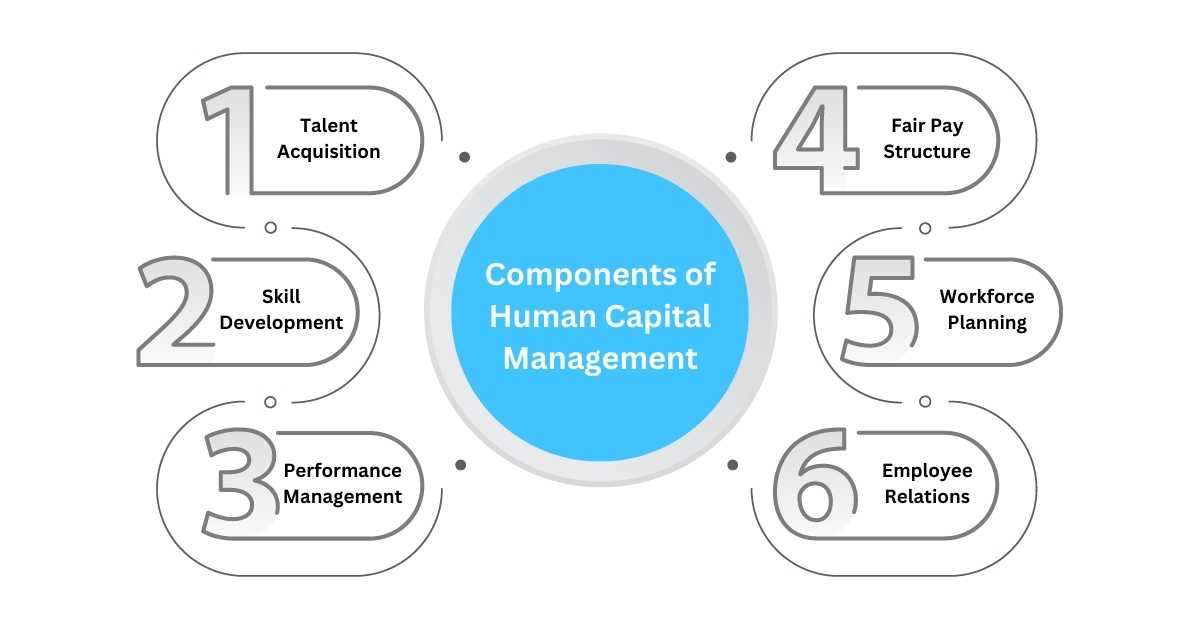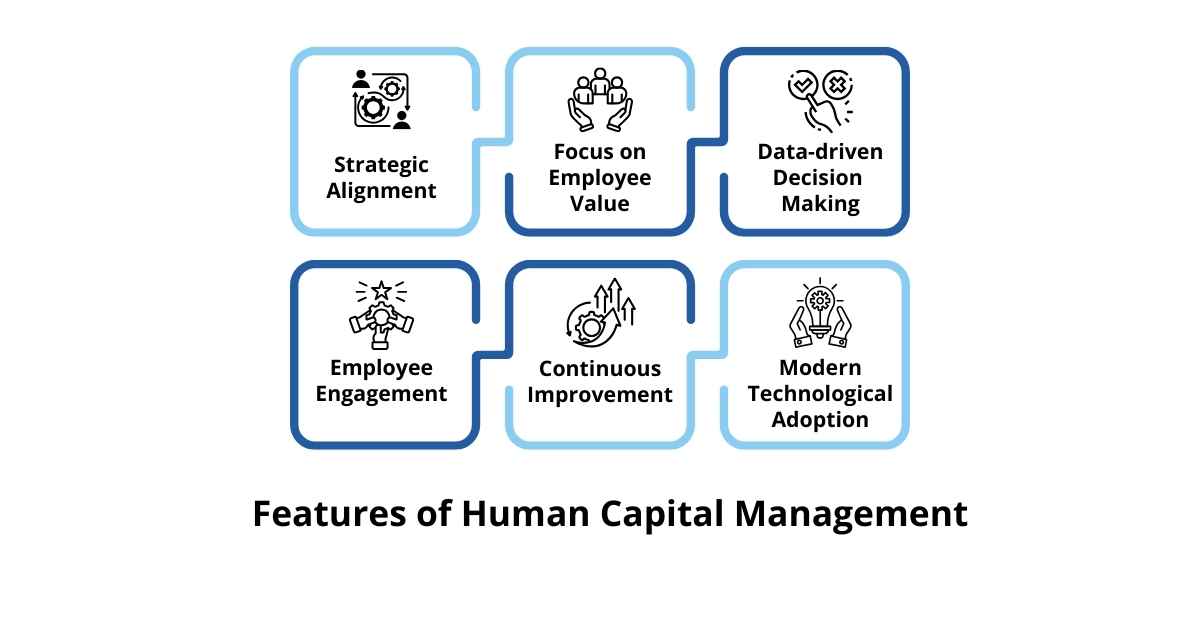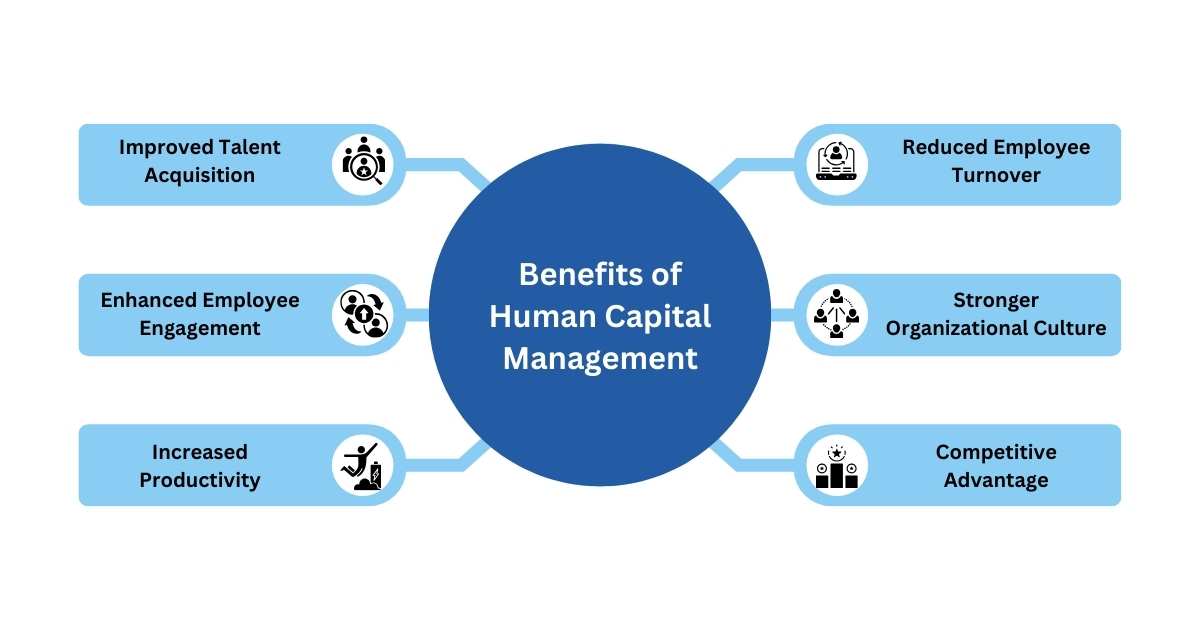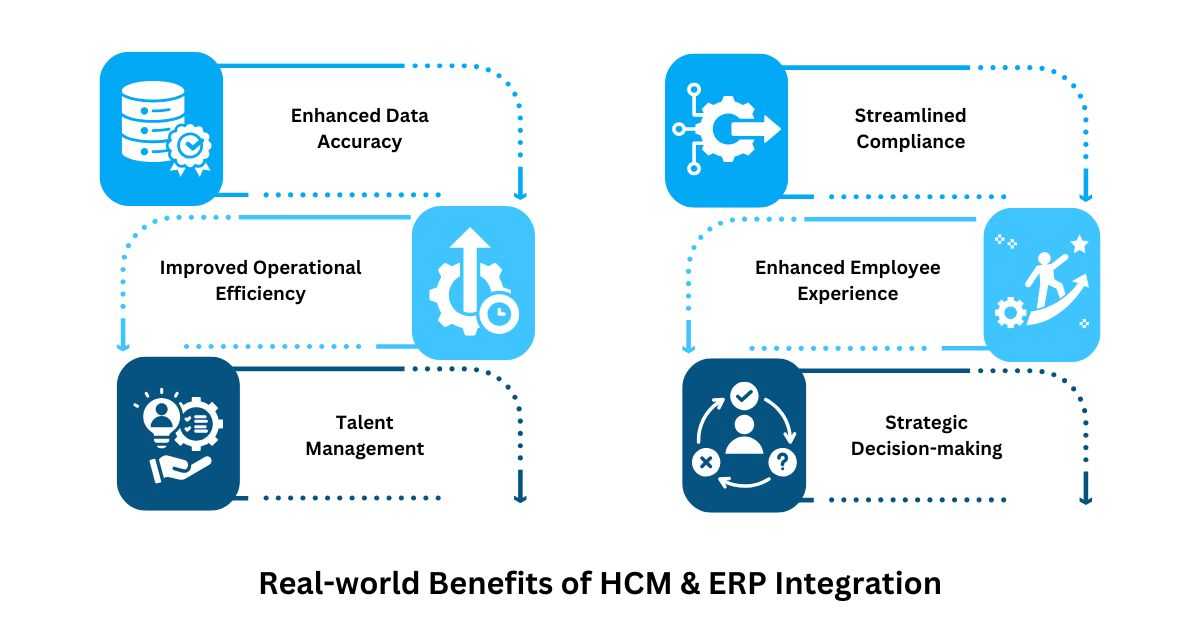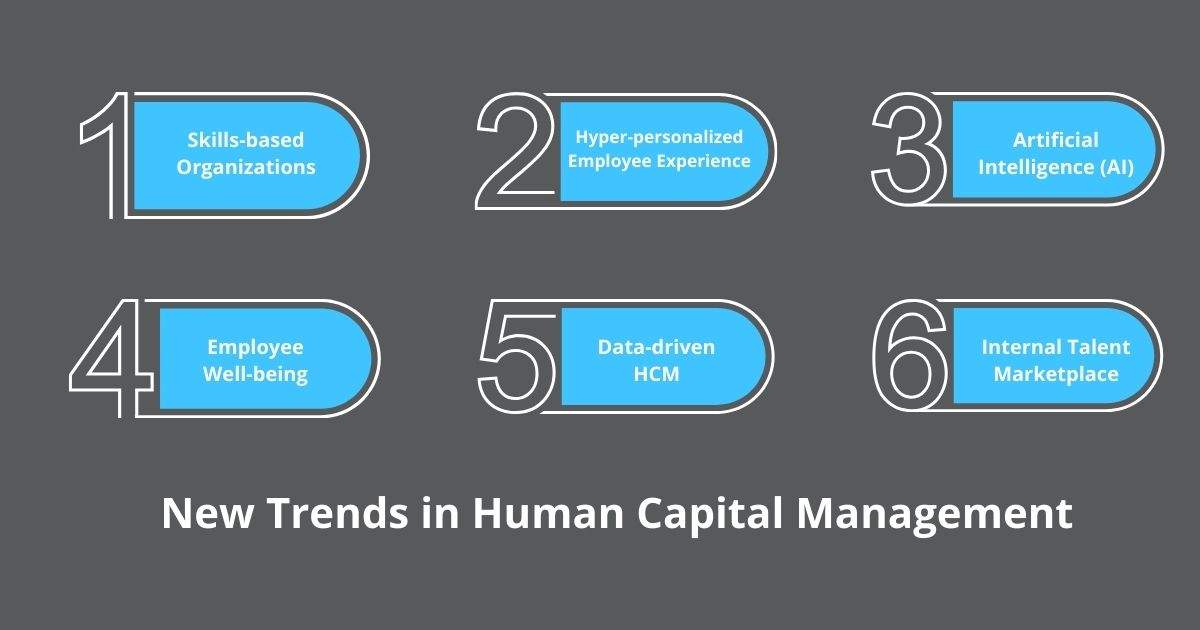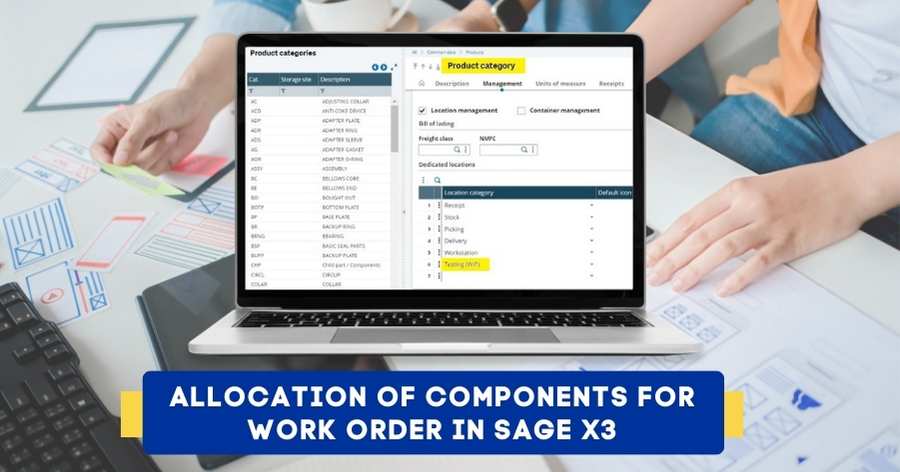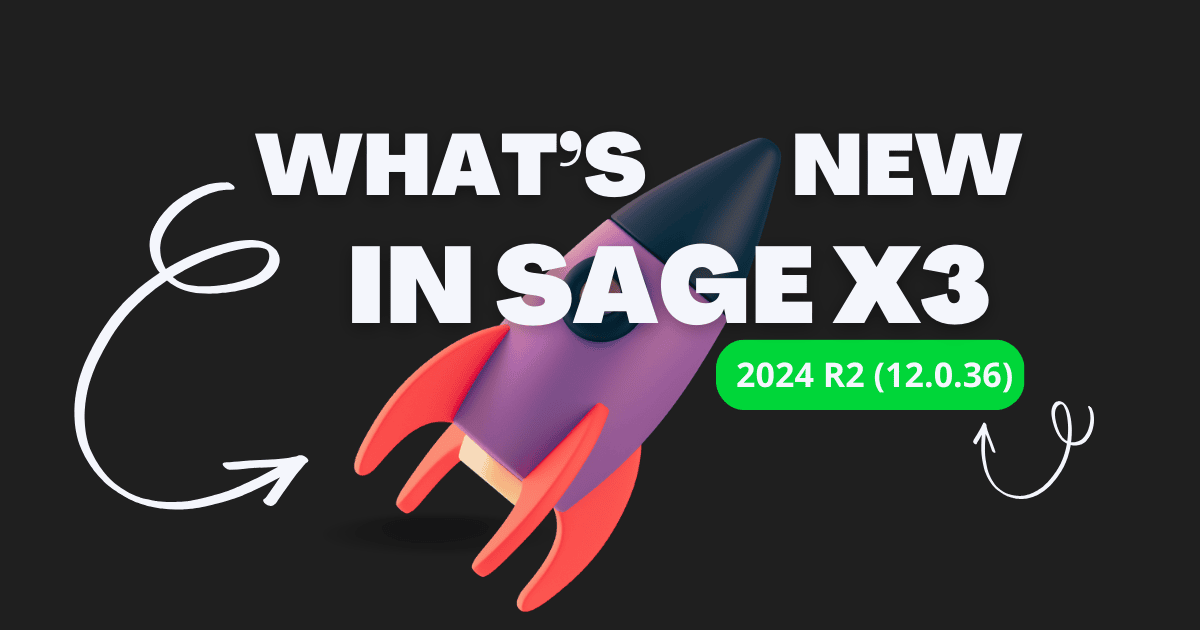What is Human Capital Management (HCM)?
Human Capital Management (HCM) is a strategic approach that views an organization’s people as its most valuable asset and investments, recognizing that their collective knowledge, skills, and abilities are key drivers of organizational success.
Integrating Human Capital Management Software and ERP Software eliminates data silos and the need for manual data entry across multiple systems. It allows businesses to align people strategies with business goals, fostering a productive and engaged workforce.
What are the Components of Human Capital Management?
1. Talent Acquisition
This component focuses on attracting, recruiting, and onboarding the right individuals with the necessary skills and cultural fit. It involves strategic workforce planning, effective sourcing methods, and a positive candidate experience. A strong talent acquisition process ensures a pipeline of qualified individuals to meet current and future organizational needs.
2. Skill Development
This crucial aspect involves providing employees with opportunities to enhance their skills, knowledge, and competencies. It includes training programs, mentorship initiatives, and career development pathways. Continuous learning and development are essential for employee growth, engagement, and organizational adaptability in a dynamic environment.
3. Performance Management
This component focuses on setting clear expectations, providing regular feedback, evaluating employee performance, and recognizing achievements. It aims to align individual and team goals with organizational objectives, driving productivity and accountability. Effective performance management fosters a culture of continuous improvement and growth.
4. Fair Pay Structure
This involves designing and administering fair and competitive pay structures, as well as comprehensive benefits packages. It aims to attract, motivate, and retain talented employees by rewarding their contributions and supporting their well-being. A well-designed compensation and benefits strategy is crucial for employee satisfaction and engagement.
5. Workforce Planning
This component involves forecasting future workforce needs based on business strategy and analyzing employee data to gain insights. It helps organizations make informed decisions about talent acquisition, development, and deployment. Effective workforce planning ensures the organization has the right people in the right roles at the right time.
6. Employee Relations
This encompasses fostering positive relationships between employees and the organization. It involves communication, conflict resolution, and ensuring a fair and inclusive work environment. Strong employee relations contribute to higher morale, reduced turnover, and a more productive workforce.
Features of Human Capital Management
1. Strategic Alignment
HCM is deeply integrated with the overall business strategy, ensuring that people-related initiatives directly support organizational goals and objectives. This alignment ensures that human capital investments contribute to achieving a competitive advantage and desired business outcomes.
2. Focus on Employee Value
HCM views employees as valuable assets and investments, rather than just operational costs. This perspective emphasizes the importance of nurturing talent, fostering growth, and maximizing the potential of each individual within the organization.
3. Data-driven Decision Making
Human Capital Management Software relies on data and analytics to inform decisions related to talent acquisition, development, performance, and retention. This evidence-based approach allows for more effective strategies and measurable outcomes in managing human capital.
4. Employee Engagement
Modern HCM places a strong emphasis on creating a positive and engaging employee experience throughout the entire employee lifecycle. This includes fostering a supportive work culture, providing growth opportunities, and ensuring employee well-being.
5. Continuous Improvement
As we’ve explained in the Human Capital Management meaning section, it is an ongoing process that involves continuous evaluation, adaptation, and improvement of people-related practices. This commitment to evolution ensures that HCM strategies remain relevant and effective in a changing business landscape.
6. Modern Technological Adoption
Human Capital Management HCM Software leverages technology solutions to streamline processes, automate tasks, and provide valuable insights into the workforce. HRIS, talent management systems, and analytics platforms play a crucial role in modern HCM practices.
Benefits of Human Capital Management
1. Improved Talent Acquisition
A strategic HCM approach enables organizations to attract and recruit higher-quality candidates who are a better fit for the company culture and job requirements. This leads to a more skilled and engaged workforce from the outset.
2. Enhanced Employee Engagement
By focusing on development, recognition, and a positive work environment, the Human Capital Management System fosters higher levels of employee engagement and motivation. Employees who are engaged tend to be more productive, more committed to their work, and less likely to leave the organization.
3. Increased Productivity
Effective performance management, training, and development initiatives within HCM contribute to improved individual and team performance. This directly translates to higher organizational productivity and better business outcomes.
4. Reduced Employee Turnover
Companies across the world are investing in employee training & personality development, employee compensation, and various other schemes to promote positive work culture and reduce employee turnover, ultimately resulting in lower costs for the organization.
5. Stronger Organizational Culture
As we’ve define Human Capital Management earlier, it practices that emphasize communication, collaboration, and inclusivity contribute to building a positive and strong organizational culture. A healthy culture attracts and retains talent and enhances overall organizational effectiveness.
6. Competitive Advantage
Ultimately, effective Human Capital Management provides a significant competitive advantage by ensuring the organization has the right talent, with the right skills, at the right time, driving innovation and achieving strategic goals.
Limitations of Human Capital Management
1. Intangible Value
Difficulty in quantifying the value of human capital.
2. Resource Intensive
Implementing effectively can be time-consuming and resource-intensive.
3. Inefficient Leadership
Success depends heavily on leadership buy-in and consistent execution.
4. External Factors
External economic and market factors can significantly impact human capital strategies.
Real-world Benefits of HCM and ERP Integration
1. Enhanced Data Accuracy
The integration between both these systems ensures a single source of truth for employee-related information, reducing errors, and inconsistencies, and improving the reliability of data used for reporting and decision-making across the entire organization.
2. Improved Operational Efficiency
Integrating these systems automates numerous HR and finance processes, such as payroll processing linked to time and attendance, and benefits administration tied to employee records. This reduces manual effort, minimizes administrative overhead, streamlines workflows, and frees up HR and finance teams to focus on more strategic initiatives.
3. Talent Management
With integrated data on workforce costs, skills, and performance from the HCM alongside project needs and financial data from ERP implementation, organizations gain a holistic view of effective workforce planning. Talent Management enables better forecasting of labor needs, identification of skill gaps, and strategic alignment of talent development with business demands.
4. Streamlined Compliance
Integration helps ensure compliance with labor laws and regulations by providing accurate and up-to-date employee data for reporting and audits. Automated workflows for processes like onboarding and offboarding, combined with centralized record-keeping, minimize the risk of non-compliance and associated penalties.
5. Enhanced Employee Experience
Human Capital Management software integration with the Best ERP Software in India can provide employees with a seamless self-service portal. This allows them to easily access and manage their personal information, benefits, pay stubs, and time-off requests, improving their overall experience and reducing the administrative burden on HR.
6. Strategic Decision-making
By providing a unified view of people, processes, and finances, the integration of the Human Capital Management System and Sage X3 empowers decision-makers with comprehensive business insights. This enables data-driven decision-making related to workforce investments, talent strategy, organizational structure, and overall business performance, leading to better strategic outcomes.
Human Capital Management VS Human Resources Management System
| Human Capital Management (HCM) | Human Resources Management System (HRMS) | |
| Focus | Strategic management of employees as assets for business goals. | Operational management and automation of HR processes and data. |
| Nature | Strategic framework and philosophy. | Technology platform and software solution. |
| Scope | Broader, encompassing talent strategy, development, and alignment. | Narrower, focusing on administrative tasks, record-keeping, and automation. |
| Goal | Maximize employee value and contribution to organizational success. | Improve efficiency, accuracy, and compliance of HR operations. |
| Perspective | People-centric and investment-oriented. | Process-oriented and data-management-focused. |
| Technology Role | Leverages technology as an enabler for strategic goals. | Technology is the core of its functionality. |
What are the New Trends in Human Capital Management?
1. Skills-based Organizations
Companies are increasingly shifting their focus from job titles to the specific skills and competencies of their workforce. This allows for greater agility in deploying talent to projects, identifying skill gaps, and fostering internal mobility based on capabilities rather than rigid roles. HCM strategies are now prioritizing the assessment, development, and tracking of individual employee skills.
2. Hyper-personalized Employee Experience
Leveraging data and AI, organizations are moving towards highly personalized employee experiences. This includes tailored learning paths, customized benefits packages, and individualized career development plans based on an employee’s unique needs, preferences, and goals. The aim is to create a more engaging and supportive work environment that caters to each individual.
3. Artificial Intelligence (AI)
Artificial intelligence and automation are no longer just tools for streamlining administrative tasks. They are being strategically integrated into core HCM functions like talent acquisition (AI-powered screening), performance management (data-driven insights), and learning & development (personalized recommendations), freeing up HR professionals for more strategic work and enhancing efficiency.
4. Employee Well-being
The focus on employee well-being is expanding beyond physical health to encompass mental, emotional, social, and financial aspects. HCM strategies are increasingly incorporating programs and resources that support this holistic view, recognizing its direct impact on engagement, productivity, and retention. This includes mental health support, flexible work arrangements, and well-being platforms.
5. Data-driven HCM
Organizations are increasingly relying on data analytics to gain deeper insights into their workforce and make more informed decisions. This includes analyzing trends in employee turnover, engagement, performance, and skills gaps to optimize HCM strategies and measure their impact on business outcomes.
6. Internal Talent Marketplace
An internal talent marketplace is a technology platform that acts as an internal marketplace for an organization’s employees. It uses AI-powered skills matching to connect employees with various opportunities within the company, going beyond traditional job postings. These platforms aim to democratize access to development and mobility by making internal opportunities transparent and accessible to all employees based on their skills and interests.
Wrapping Up
In conclusion, Human Capital Management is a critical function for any organization striving for sustained success in today’s competitive landscape. By viewing employees as valuable assets and strategically managing their lifecycle, businesses can unlock their full potential and achieve their strategic objectives.
Embracing the principles of HCM, from effective talent acquisition to continuous development and engagement, is not just a matter of best practice, but a fundamental driver of organizational growth and resilience. Nurturing your employees is a powerful investment in your future success.
FAQs
1. How to Define Human Capital Management in Simple Words?
A simplified Human Capital Management meaning is that it is an activity that encompasses a range of practices designed to optimize the employee lifecycle, from recruitment to offboarding. It seeks to create a competitive advantage through its human capital and focuses on attracting, developing, and retaining top talent.
2. What is Human Capital Management (HCM) in ERP?
Human Capital Management (HCM) is an important feature of the ERP Application. It offers a set of functionalities designed to manage an organization’s workforce, centralize employee information, and streamline HR tasks such as employee benefits & payroll. Let’s take an example: The HCM module within the Manufacturing ERP aims to align HR activities with overall business objectives, providing a unified platform for managing the entire employee lifecycle from hire to retirement.
3. What is the Primary Goal of Human Capital Management (HCM)?
The main goal of HCM is to strategically manage employees as valuable assets. It focuses on maximizing their potential and contributions to achieve organizational objectives. HCM aims to align people strategies with overall business goals. Ultimately, it seeks to create a competitive advantage through effective talent management.
4. How Does HCM Differ from Traditional HR Administration?
Traditional HR administration primarily focuses on operational tasks and compliance. HCM takes a more strategic and forward-thinking approach to managing talent. It emphasizes employee development, engagement, and their impact on business outcomes. HCM views employees as investments rather than just costs.
5. What Role Does Technology Play in Modern Human Capital Management?
Technology, such as HRIS and talent management systems, streamlines HCM processes. It enables automation of tasks like payroll, recruitment, and performance management. Technology provides valuable data and analytics for informed decision-making. This empowers HR professionals to dedicate their efforts to more strategic initiatives that drive organizational success.
6. How Can Small Businesses Benefit from Implementing HCM Principles?
Even small businesses can benefit from strategically managing their limited workforce. HCM principles can help attract and retain key talent in a competitive market. Focusing on employee development can maximize the skills of their existing team. A strategic approach can lead to increased productivity and overall business growth.
7. How is the Effectiveness of HCM Initiatives Measured?
Key metrics include employee turnover rate to assess retention. Employee engagement scores from surveys indicate satisfaction and commitment. Time-to-hire and cost-per-hire measure the efficiency of talent acquisition. Performance metrics track the impact of development programs. Revenue per employee can reflect the overall effectiveness of human capital.

